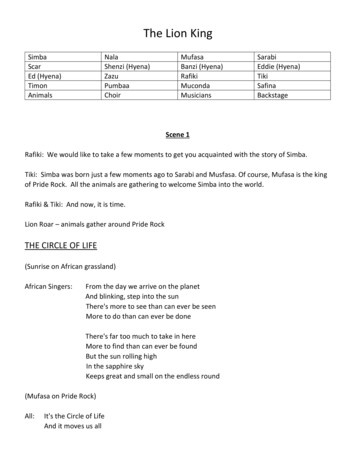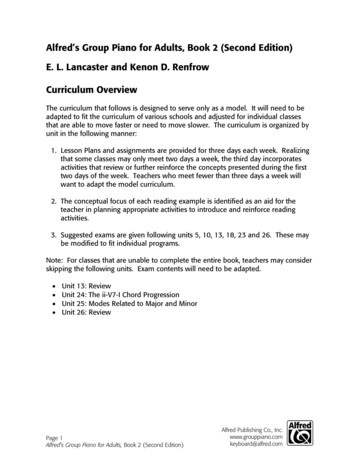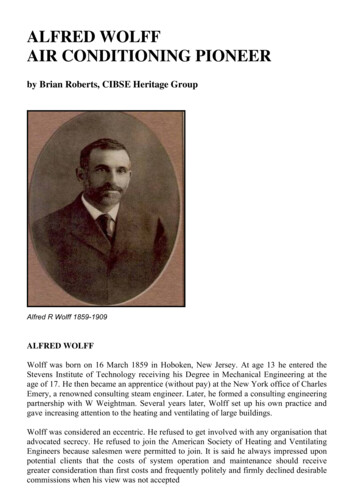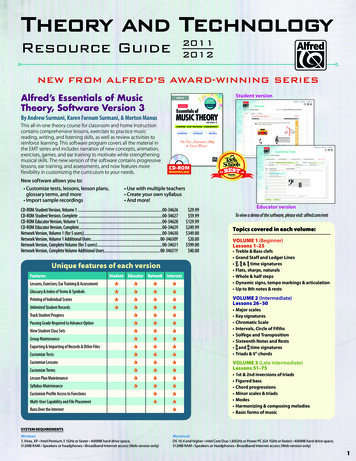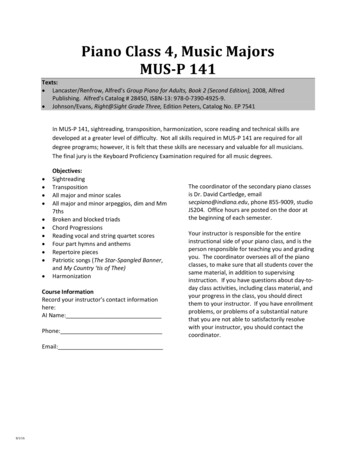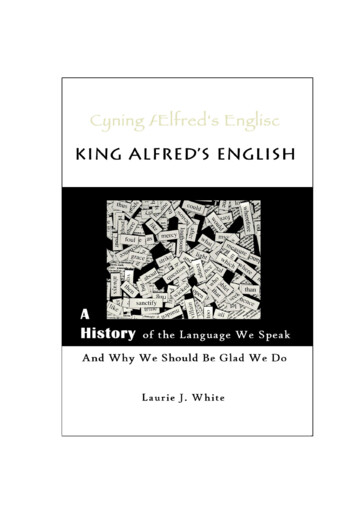
Transcription
King Alfred's EnglishA History of the Language We Speakand Why We Should Be Glad We DoLaurie J. White
King Alfred's EnglishCopyright 2009 by Laurie J. WhiteAll rights reserved. No part of this book may be reproduced or transmittedin any form or by any means without written permission of the author.Library of Congress Control Number: 2007902186ISBN for Softcover Edition: 978-0-9801877-1-7The Shorter Word Press1345 Butler Bridge RoadCovington, GA 30016-4935www.theshorterword.comCover image by Comer Turley, Turley Photography LLC
The Middle AgesAncientTimesModernTimesFrom the middle of the first millenniumTo the middle of the nextWilliam theConqueror500 ADBC†ADPre-EnglishBritainunder Roman ruleO l d Eng l i shFallOfRome476Old EnglishInvasion ofLatin& Old NorseMiddle EnglishInvasion ofFrenchModern EnglishInvasion ofGreekplus more Latin1500 AD1066Middl e EnglishModern Engli shRenaissanceThe Bible remains“locked-up” in Latinuntil the Reformation.Reformation c. 500 AD—King Arthur (if he really lived) 731—Bede finished his EcclesiasticalHistory of the English People c. 800—Beowulf written 871—Alfred became king of Wessex 1016—King Cnut won the throne of England 1066—William conquered England; French became the official language of the English court 1382—Wycliffe’s Bible (handwritten) began circulating in England 1400—Chaucer died with The Canterbury Talesunfinished 1456—Gutenberg’s Printing Press 1476—Caxton’s printing press—1st in England 1526—Tyndale published the first English NT inprint; executed for heresy 1536 1611—King James Bible published 1616—William Shakespeare died
Free supplemental material for students is available atwww.theshorterword.com Chapter Worksheets Unit Tests Links to related online literature and primary sources Links to articles, images, and videos that expand the topics in eachchapter Suggested movies
In memory of my mother, Frances Napier Jones,who loved books, poems, grammar and, most of all, Alfred.
AcknowledgmentsI’d like to thank Dr. Frederick Montesor, a former college professorof mine. I took his History of the English Language course back in 1972 atAuburn University. Dr. Montesor’s enthusiasm and knowledge gave me alasting love for the subject of how English developed. Thirty years later, Istill had all of my notes and handouts from his class and was able to usethem as a reference and guide to help me research this book. My emphasison the “language law” comes straight from him.Thank you to Fran and Bob Lewis, my promoters and encouragers,who gave the chapters their first proofing as I churned them out. Theyprodded me to keep after it and their corrections and suggestions werethoughtful and vital, helping me cut through random ideas and stay ontrack. Marika Mullen was invaluable as she gave the manuscript moreprofessional editing. Also, I appreciate Sue Jakes, author and editor forGreat Commission Publications, taking the time to read my manuscript.Her enthusiasm for the project was such an encouragement that I kept herinitial phone message on my answering machine for two years so I couldreplay it whenever I hit a slump. Finally, thank you, Anne Dicks! Yourescued me on the final lap and, in the midst of your own busy schedule,gave the book a final proofing.I’m grateful to Roger Walshe at the British Library for his help andthrough whom I received permission to use their website’s activity pages inmy online supplemental material. The library’s website is user friendlywith quality lessons for students and it was a continual resource for me.Finally, thanks to Rebecca, Hetty and Robert Lee for being myguinea-pig students and for being interested in this material long before itwas in a book.
Table of ContentsPart I.Pre-English BritainChapter 1.55 BC – 500 AD. .1When Togas and Latin Came to Britannia. .3Caesar Conquers Gaul and Britannia.3Fighting Druids .5Constantine.7The Gospel in a Shamrock . 8Rome Gets Vandal-ized.9The End of an Empire and the Close of an Age .10Chapter 2.Well, We’re Through with the Romans, So Who’s Next?. .11How Do You Un-Invite a Jute?. 11King Arthur and the Knights of the Round Table . 13Part II.Chapter 3.Old English500—1066 .15A Little About Language .17Old English . 17The Grammar Game .18The Language Law . 19Language—Evidence for Design. 21Sir William Jones Goes to India .22The Brothers Grimm .23An Inflected Language . 24More Invasions. 26Chapter 4.The Invasion of the Church and of Latin .27Augustine of Canterbury.27Bert and Bertha . 29From Saxon Runes to Roman Alphabet. 30The Gast and the God Spell . 31Our Pagan Days . 31Latin: An International Language for Scholars.32The Language that Became a Prison .32Illuminated Manuscripts . 34
The “Our Father” . 35I Hate to Be Confusing, But. . 36A Monk You Should Know: The Venerable Bede .37Beowulf . 39Cædmon’s Hymn: A Closer Look at Anglo-Saxon Poetry . 39A Summary of Our History So Far: To Britain . 42Chapter 5.The Invasion of the Vikings and Old Norse. .45The Original Meaning of Berserk . 45King Alfred. 47King Cnut . 50Old Norse Meets Old English . 50Part III.Chapter 6.Middle English1066—1500 .55The Invasion of the Normans and Old French. .57William the Conqueror .57Language du Jour. 59The Abandoned Chronicle . 60Chapter 7.The Making of Middle English .63The Beginning of the Middle . 63Losing Our Gutturals . 63WH and CW Bite the Dust . 64From Hog in the Barnyard to Pork on the Table . 65The Hundred Years’ War . 66Geoffrey Chaucer . 68John Wycliffe and the First English Bible . 69From Fæder to Fadir . 71Some Þoughts On Þ .72Chapter 8.And the Word Became.Print! . .75Johannes Gutenberg .75The Mystery of English Spelling.77Spelling Caxton’s Way.77English Spelling and the Great Vowel Shift . 78Part IV.Chapter 9.A Time of Transition– From Middle to Modern English1400 – 1600 (or thereabouts) .81The Invasion of Greek .83
The Middle, the Modern, and the In-Between . 83Rebirth of Ancient Knowledge . 84The Byzantine Empire . 85Re-Capturing Greek . 86A Well-Documented Faith . 86All this Plus Print . 88Greek-Speak . 88Chapter 10.“Sola Fide”— A Battle Cry for Faith. .91Martin Luther . 91Purchasing Salvation—Hmmm. Didn’t Jesus AlreadyDo That?. 93The End of the Middle .95Part V.The Making of the English Bible1526—1611 .97Chapter 11. English Contraband: Fulfilling Wycliffe's Dream .99Outlawing English. 99Enter Henry VIII . 100Scriptures for a Ploughboy . 101Erasmus .103Translation Trailblazing .103Tyndale’s Word Choices.104Tyndale’s Inventions .105Translating the Bible—A Political Activity?.106Chapter 12.Of Kings and Wives and Martyrs. .109Obsession for a Son.109When a Powerful King Wants an Unobtainable Divorce . 110Heads Begin to Roll. 110The 1534 Convocation of Canterbury.111A Prayer for the King.111Chapter 13.The Bible That Was Named for a King. .115The Geneva Bible. 115A Succession of Monarchs . 115James I of England. 116The Apocrypha . 118Southern Dialect Wins Again . 118The English Civil War and the Bible . 119America and The King James Bible .120Euphemisms and Shifting Sensibilities .120Whacky but True: Shakespeare in a Psalm. 121
Those Lingering Pronouns for God .124The Legacy .125The Man Behind the Team .126Part VI.Chapter 14.Shakespeare and Modern EnglishFrom 1500 Onward .127Shakespeare .129A Class By Himself .129Shakespeare’s Inventions. 130The Extent of His Knowledge . 131His Insight .132Chapter 15.If Only King Alfred Could See Us Now! .135The Genesis of Grammar Rules .135I Ain't Going to Use No Double Negatives .136That or Which? .136A Few Predictions.137The Largest Dictionary in the World.138The British Empire .138English--American Style .139New Words for a New Age . 140Outlawing E-mail . 141Liberté Pour Les Mots! (Liberty for Words!). 141Mr. Crapper .142How Words Morph and Mutate .143The Biggest Language Invasion of All: English Invadesthe World .144Resources .147About the Author .151
Your Native TongueWhat does it mean to say a particular language is your “nativetongue”? Perhaps, more than you think. Did you know that in recent yearsit was discovered that if you learn a language before the age of puberty,you learn it in an altogether different part of your brain? Also, researchershave found that unless you learn a language as a child, and in this othermental compartment, you will probably never speak it without an accent.The language you learn as a small child is the language of yourheart. It is the one in which you call out when you are hurt, the one inwhich you holler when you lose your temper, the one in which you pray.Is English your native language? If it is, then what we are about tostudy is the language of your heart and the wonderful and sometimes verysurprising ways by which it grew to be the crafty, agile, skillful, undaunted,cardio-kleptic language that we speak!Crafty Old EnglishAgile LatinSkillful Old NorseUndaunted Old FrenchCardio-kleptic (heart-stealing) Greek
Part IPre-English Britain55 BC – 500 ADHave you ever wondered why England has twonames? It is sometimes called Britain and sometimesEngland. Of course, it is also called the “UK” for theUnited Kingdom, but that came about in moderntimes. The names Britain and England are mucholder.However, at the very first of our story, England was not yet called England either. In ancienttimes it was just called Britain and no one had evenheard of England or the English language. In fact,when Julius Caesar came to Britain in the century before the birth of Christ, Britain was just a primitiveland on the outskirts of nowhere. It was inhabited bywild and warring clans of people who, a few centurieslater, would end up doing their very best to preventthe English language from ever coming to the shoresof their island home. They were highly unsuccessful.
When Togas and Latin Came to BritanniaChapter 1Veni, Vidi, Vici.“I came, I saw, I conquered.”Julius CaesarCaesar Conquers Gaul and BritanniaIn 55 BC Julius Caesar landed in what we know as England today.He called it Britannia, the land of a people known as the Britons. He hadjust finished his conquest of Gaul, the old Roman name for France. Boththe Gauls and the Britons were part of a much larger group known as theCelts (pronounced Kelts or Selts, either way).There are some very definite characteristics that make historianslump these people together into one group. The first is their languages.From studying the grammar and vocabulary used by these Britons andGauls, linguists can tell their languages were close kin and from a commonbase. They also had the same religion for the most part, that is, the Druidicreligion. Druids were a special class of men among the Celtic people. They
King Alfred's English4were the rulers, the leaders in warfare, and also the priests. They led thepeople in the worship of many gods and a strong belief in the afterlife.They thought oak trees and mistletoe were sacred and held most of theirreligious rites and sacrifices in oak forests. Our custom of kissing underthe mistletoe at Christmas time is a cute twist on some old Druid beliefs.Other areas around Britain besides Gaul were also Celtic at thistime. Look at the map just inside the cover of this book. Find Wales. It ispart of the same island as Britain but is separated from the rest of Britainby mountains. Now look at Ireland, which is separated, obviously, by theIrish Sea. Then there’s Scotland, the top part of Britain. Like Wales,Scotland is separated from the rest of the island by rough, mountainousterrain. Last of all, in the south is little Cornwall. By now you can guess:there’s another mountain range separating Cornwall from the rest ofBritain. Whenever you see distinct differences in culture between areasthat are close together on a map, you can bet there is some geographicalfeature that separates the two, something hard to cross like a wide desertor a rugged mountain range. In 55 BC, Celtic people inhabited all of theseplaces—that is, Gaul (France), Britain, Wales, Ireland, Scotland, andCornwall. (Notice that England did not yet exist.) All these areas had theirown dialects, tribes, and chiefs, but all were Celts. There was anothergroup of Celts who had settled in Asia Minor, our present-day Turkey.Their Celtic language was Gallic for they were related to the Celts in Gaul.The apostle Paul wrote them a letter and it is part of our New Testament:the book of Galatians (Gaul-atians).After conquering Gaul, Julius Caesar sailed across the EnglishChannel to conquer Britannia just to say he could. Caesar didn’t likethinking that anyone was above Roman rule. Britain was of no real use tothe Romans at that time, and the Romans didn’t really intend to settlethere. They hated the climate. It was rainy and chilly, and though it wasnever terribly cold, it was never terribly warm there either. So Caesar builtsome temporary fortifications and left a few troops there, but only for ashort while.Then, around a hundred years later in 43 AD, Emperor Claudius Idecided that Rome should go back to Britain, re-conquer it, and this timeestablish some permanent forts and buildings and convince a few Romansto actually settle there.
When Togas and Latin Came To Britannia5Fighting DruidsTheCelticpeopleinBritain were fierce fighters, butthey didn’t stand much of a chanceagainsttheRomanEmpire’sadvanced weapons and war tactics.The Romans had catapults and acavalry, and, to top it off, theRomansevenhadtheirownversion of a tank—elephants. Youcan imagine what the averageBriton thought of these huge,strange beasts. He’d never evenheard of an elephant, let aloneseen one. The Romans floatedthem over the rough waters of theEnglish Channel and terrorized the Britons with them. But more importantly, the Roman army was a highly organized and trained war-machine,unlike the Britons who were only temporarily banded together to fight acommon enemy. Britons, as a matter of fact, usually spent a great deal oftime fighting each other.However, the Romans had to fight much longer and harder thanthey had anticipated because these Celtic Britons did have two distinctfactors on their side. First, they were absolutely fearless warriors. Theyfought at times with such total abandon that they sent waves of terrorthrough the ranks of even the battle-hardened soldiers of Rome. Theysometimes dyed their faces blue, as did the Celtic Scots in the movieBraveheart, and gave out fearsome, bloodcurdling battle cries as theycharged. (Some historians think their battle cry may have been the forerunner to the famous rebel yell of the Southern soldier during the American Civil War). Along with the blue faces and the hollering came loudblasts from a multitude of blaring war-trumpets made of rams’ horns. Thewhole effect was pretty overwhelming.Second, their women often fought alongside the men and wereeven scarier! The wives of the Druid priests reportedly fought with avicious frenzy unlike anything the Romans had ever seen. Tacitus, aRoman historian, described an attack by Druid warriors: “On the shorestood the opposing army with its dense array of armed warriors, while
King Alfred's English6between the ranks dashed women in black attire like the Furies, with hairdisheveled, waving brands.” Another Roman author, Marcellinus, described a Celtic woman fighting “with flashing eyes, she.begins to rainblows mingled with kicks like shots discharged by the twisted cords of acatapult.” There was a Celtic queen of this era named Boudicca. When herhusband was killed by Roman soldiers, she led her people in severalamazingly successful battles against the Roman army, but was then finallydefeated. Our word bodacious, meaning outlandishly bold, comes from hername. Bodacious sounds like a good adjective for Celtic women in general.In the end, the ferocity of the Celtic warriors could not defeat theimmense and efficient army of the Roman Empire. Claudius eventuallywon, and Britain came under Roman rule. After victory was more or lesssecured, the Romans began setting up a few forts that eventually becametowns. The most important of these was Londinium Fort. It, of course,turned into London, the capital city of present-day England. London islocated on the Thames River (not pronounced as it is spelled—say Tĕmz).The Thames became a kind of liquid highway for travel and trade inEngland.Some of the Celts in the northern regions, especially the Picts andScots, were harder to subdue. They kept on attacking Roman outpostsuntil Rome gave up on trying to control these rowdy hordes. Finally, aftera century or so of fighting off these early Scottish highlanders, the RomanEmperor Hadrian built a rock wall to mark the northern boundary ofRoman rule. The wall was eight feet thick, 20 feet high, and 80 miles long.It kept the un-subdued Celts separate from the subdued Celts. Most of thewall still stands there today. It is known as Hadrian’s Wall (see map).The Romans founded several towns: Bath, Canterbury, Caerphilly(in present-day Wales), as well as London, to name a few. With buildingsas high as four and five stories, tiled roofs, beautiful mosaic tile floors,plumbing, and even central heat in the nicer homes, these towns flourished. Picture a bustling town brim full of educated nobility, servants,slaves, and a solid middle class all speaking Latin and wearing togas inEngland! And it lasted almost 400 years.Many Roman ruins can still be seen in England today. The city ofBath, known for having the only hot springs in England, has some of thebest-preserved Roman buildings and baths. Roman roads can still be seenin many places as well. In fact, Rome was famous for her roads. There wasnothing like them anywhere else in the world. Paved with stones, extend-
When Togas and Latin Came To Britannia7ing miles and miles crisscrossing a vast empire, they made the travelingeasier for certain evangelistic apostles of the first century AD to take thegood news of a Savior to all parts of the world. The Roman Empire persecuted Christians off and on for nearly three centuries, but despite beingfed to lions in the Coliseum and other Roman cruelties, the Christiansendured, and their faith spread like a brush fire. Throughout history, thewinds of persecution have always made the fire of the gospel burnbrighter, and those wonderful Roman roads literally paved the way for thesparks to spread.ConstantineIn the fourth century AD, a man named Constantine was fightingin a civil war over the throne of the Roman Empire. One day he had avision. There are several variations to the story, but basically he claimedthat he saw the “sign of the Christ” in the sky and a voice telling him hewould win if he fought under that sign. With renewed hope, he had thefirst two letters of the word Christ in Greek, chi (Χ) and roe (Ρ), put on thestandards of his army. He won the battle and converted to Christianity.Constantine became Rome’s first Christian emperor and he made Christianity legal all over the empire. Finally, the persecution of Christians by theRoman Empire was ended.The Chi-Rho symbolfor Christ is always depictedwith the Chi placed overtheRhopresumablyasConstantinesawinhisvision. The symbol has beenusedbythechurchthroughout history and isstillpopularreligioustodayartworkinfromstained glass windows to352 AD Roman coin showing the Chi Rhosymbol on the back. Used with permission.www.cngcoins.comaltar cloths. Occasionally at Christmas time, you might see someone usethe abbreviation Xmas for Christmas. This shorthand for Christmas is notsacrilegious as some people think. It is not x-ing out Christ, but ratherusing the traditional Greek initial Chi to stand for the first letter of Christin Greek, just the way Constantine did.
King Alfred's English8By the time of Constantine’s conversion, there were already groupsof Christians in England among both the Romans and the Britons wholived there, and now that the emperor himself was a Christian, they couldopenly worship the Savior without fear of persecution. The new faithspread and many more people were baptized. As history testifies, thisnewly adopted religion of Rome would prove to be even more durable thanits stone-cobbled roads.The Gospel in a ShamrockIt was during this new Christian era of Rome’s occupation that acertain sixteen-year-old boy in Britain was kidnapped by a raiding partyfrom Ireland. The Irish were still a pagan people and made a habit ofpirating the coastal lands nearby whenever they felt like it. The boy’s namewas Patrick. His captors took him back to Ireland where they sold him as aslave to a farmer. He endured long, hard months of labor under a harshowner who didn’t understand a word of Patrick’s language.Though Patrick’s parents were Christians, Patrick himself hadnever thought too much about religion and had not committed his life toChrist. Now, he had plenty of time to think about God while he slept out inthe cold watching the farmer’s sheep, and, with his situation both desperate and miserable, it wasn’t long before he sought to be reconciled to theonly One who could help. He surrendered his life to God. As Patrick wrotelater in his Confessio, “[God] guarded me, and comforted me, as would aFather his son.” Then one night he heard a voice saying to him, “See, yourship is ready.” Patrick believed it was God telling him to escape. So, herisked the harsh punishment that awaited him if he were re-captured andheaded for the coast. A ship bound for France “just happened” to bedocked right where Patrick ended up, and the captain was willing to takehim aboard if he helped with the work. He arrived in France and made hisway to a monastery. He stayed and studied under the monks for a whilebut eventually was able to travel back home to Britain. He would haveliked nothing better than to just stay there, but God had other plans.Patrick began to sense that the Lord was calling him to take thenews of the gospel to the very folk who had so brutally enslaved him.Returning to Ireland, he spent the rest of his life in a missionary effort towin the Irish tribes to Christianity. Because of the great success of his
When Togas and Latin Came To Britannia9work there, we know him today as St. Patrick, and St. Patrick’s Day iscelebrated each year in his honor.Irish tradition says that Patrick used the common three-leaf clover,or shamrock, to explain the concept of the Trinity tohis new converts. The shamrock remains the mostrecognized symbol for Ireland to this day, and in thehearts of Christians everywhere it stands for God’smiraculous work in and through the man namedPatrick.Rome Gets Vandal-izedThe Roman Empire started having major problems around thistime—from both inside and out. Inside, it was inflation, governmentcorruption, and a huge government debt. Outside, it was Germans. Yes,Germans, but they weren’t called that yet. “Germania,” the general area weknow as Germany today, was full of heathen tribes like the Ostragoths, theVisigoths, and the Vandals (from which we get our words vandal andvandalism). These tribes were uncivilized and uneducated compared to thehighly advanced and educated Christian Romans, and they liked theclimate of Italy and France and the loot they found when they won a city.So, they started coming down into Gaul and Italy to take over one city afteranother. They had no centralized government, but they had a commonreligion and culture, and their languages had a common base whichlinguists group together as being Germanic.As Roman cities came increasingly under attack from these northern barbarians, Rome began to bring her troops closer to home, abandoning the more distant outposts and far-off places. Britannia fit thatdescription. So, in 410 AD the last of the Roman troops left Britain. Thetowns and forts were abandoned. Latin would never again be the commontongue in that part of the world. But, hey, that left the Celts free at lastafter having their territory occupied by foreigners for centuries. Culturallythey were still distinctly Celtic, not Roman. However, they had addedChristianity to their cultural soup, along with its accompaniment of welleducated monks and priests and the language of Latin, the language usedby scholars for all formal books and important records.
King Alfred's English10The End of an Empire and the Close of an AgeNow, look at the timeline at the front of this book. Officially, Romefell as an empire in 476 AD. Historians mark the end of the Roman Empireas the official close of ancient history. The next period—with which most ofthis book is concerned—is the Middle Ages. If you round up the date forthe fall of the Roman Empi
& Old Norse Invasion of Greek plus more Latin Ancient Times . . it was discovered that if you learn a language before the age of puberty, you learn it in an altogether different part of your brain? Also, researchers . cardio-kleptic language that we speak! Crafty Old English Agile Latin Skillful Old Norse
